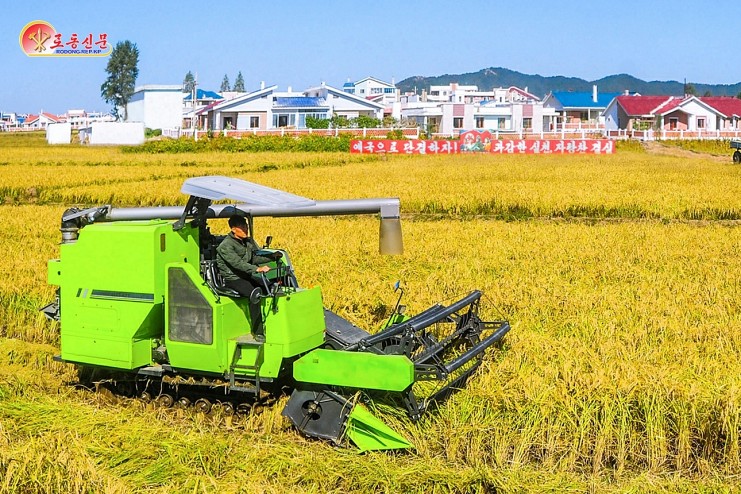 North Korea’s Rodong Sinmun newspaper reported on Oct. 8, 2024, that this year’s rice harvest was expected to exceed plans by more than a ton on average and that threshing began one week earlier than last year due to applying scientific farming techniques per the Juche farming method. (Rodong Sinmun, News1)
North Korea’s Rodong Sinmun newspaper reported on Oct. 8, 2024, that this year’s rice harvest was expected to exceed plans by more than a ton on average and that threshing began one week earlier than last year due to applying scientific farming techniques per the Juche farming method. (Rodong Sinmun, News1)
North Korean markets are experiencing severe price inflation as the U.S. dollar continues strengthening against the local currency, creating economic hardship across the country.
Multiple sources inside North Korea report the dollar crossed 40,000 North Korean won in mid-August, representing a fivefold increase from approximately 8,000 won following the COVID-19 pandemic’s end. This dramatic currency depreciation has created a stark divide between those with access to foreign currency and those dependent on the local won.
The currency crisis has triggered unprecedented price increases for basic commodities. Rice and corn, which maintained relatively stable prices around 4,000 won and 2,000 won per kilogram respectively for the past decade, have surged to 20,000 won and 6,000 won per kilogram. Since grain represents roughly 70% of personal consumption, this increase signals even steeper price rises for imported goods and general consumer items priced in foreign currencies.
Multiple factors converge to fuel economic instability
Several interconnected factors appear to be driving this exchange rate-induced inflation.
External pressures have intensified since late last year, including uncertainty surrounding U.S. trade policies and their broader impact on international markets. North Korea’s deepening involvement in Russia’s war in Ukraine has further constrained trade relationships with China, reducing the supply of available goods while international sanctions continue.
Domestic factors have compounded these external pressures. Military expenditures on nuclear weapons, missiles, and submarines continue consuming significant resources, while large-scale construction projects including 50,000 new homes in Pyongyang and the “20×10” regional development initiative represent substantial capital investments during a period of economic strain.
North Korea’s rigid economic structure amplifies the impact of currency fluctuations. In an economy with limited trade flexibility, dollar appreciation immediately affects won-denominated prices for imported goods. The country’s inflexible market pricing system, where prices rarely decline once increased, suggests these elevated costs may become permanent features of the economic landscape.
The cumulative effect has created what many North Koreans describe as the most difficult economic conditions since markets first emerged in the country three decades ago. This assessment reflects not only current hardships but also the sustained nature of the crisis.
The situation highlights fundamental structural challenges within North Korea’s economic model, where forced self-reliance policies designed to protect the regime have created distribution weaknesses that magnify the impact of external economic shocks. Without significant policy adjustments toward greater market openness and international engagement, currency volatility will likely continue creating severe hardships for the population, particularly those without access to foreign currency or significant economic resources.
